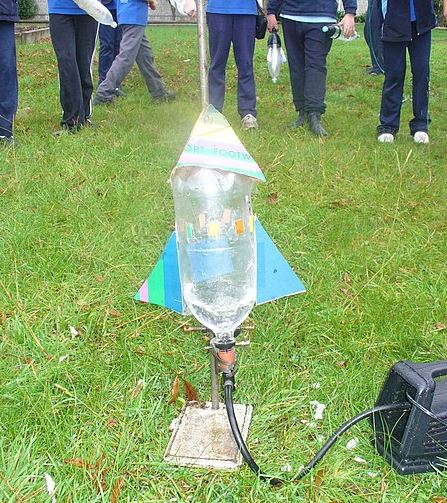If you are looking into learning about launching rockets, one of the best science projects that you can try is making some bottle rockets. This is a fun activity that involves launching a plastic bottle with the use of water and pressure. When constructing a model rocket, one of the important things that you should not forget is adding a parachute. Bottle rocket parachutes are essential as they help slow down the bottle during its landing.
Real spacecraft also use parachutes, as they help slow the spacecraft down during its entry, descent, and landing. It is usually located in the back shell of the spacecraft. The parachutes for spacecraft are made using durable and lightweight fabrics, mostly polyester and nylon, along with other strong materials for the other parts. With this, we can say that adding a parachute is also important when you create a bottle rocket.
If you are wondering why you need to add bottle rocket parachutes, we are here to explain further. In this post, we’re giving you some of the reasons for using bottle rocket parachutes.
Why are Parachutes Important for Bottle Rockets?
A rocket parachute is designed to withstand exceptional environmental exposure and to perform reliably even after immersion in water. It is an important part of the bottle rocket as it helps slow down the fall of the bottle, preventing it from getting damaged. The force that makes the parachute fall is gravity. It is what holds everything on Earth and keeps the Earth in its place in the Solar System. Due to gravity, the parachute of the bottle rocket is forced down. However, air resistance pushing up on the flat surface of the parachute causes the bottle to fall slower on the ground.
All parachutes are made for one fundamental purpose, which is to slow the gravity-driven fall of an object through the air. They take advantage of atmospheric drag, which is a physical quantity that is often a nuisance than a boon for engineers. Just like in space travel, parachutes are essential for bottle rockets for recovery. For instance, a rocket will deploy a parachute after being dropped, then it will splash down into the ocean safely with the help of a parachute.
We can also compare it to airplanes that also use a parachute recovery system to protect them from crashes. By pulling a big red lever in the plane when the pilot feels he has lost control, the airplane and parachute will glide gently to the ground. Parachutes are indeed simple pieces of technology with one important purpose, to slow down fast-moving objects.
Parachute Deployment Mechanism for Bottle Rockets
There are various ways to eject parachutes from bottle rockets. One of those is the Side Deployment or Horizontal Deployment. In this way, the parachute is deployed in a perpendicular direction to the rocket body axis. In addition to that, the other common way is to separate the nosecone and have the parachute come out in line with the rocket axis. This is how most amateur pyro rockets are operated.
To create a parachute for a rocket, you first need to choose what materials to use. For bottle rockets, simple plastic bags can be used. Here are some of the steps you can follow:
- The first step is to mark the center, fold, and cut. Mark a circle and dot in the center of the material.
- Then, measure out the cords and attach them. Measure out three cords that go from a corner to the middle of the opposite edge to the adjacent corner.
- Lastly, gather and tie the cords. Gather up the six corners so that you will be able to pull the cords even.
Another question you might have is the size of the parachute for a bottle rocket. If you are using a 2-liter plastic bottle rocket that weighs around ¼ pound or 4 ounces, a 10-20-inch diameter parachute that is made from a plastic garbage bag will work well. If you want more tips, you can also check out our Ideas for Adding Parachutes to Your Water Rocket.
Different Types of Parachutes for Bottle Rockets
When it comes to the design of the parachute for bottle rockets, there are lots of options to choose from. Here are some examples:
- Round
This type of parachute relies on the drag to slow a descent instead of having any lift. They are dome-shaped canopies that can make a bottle rocket land slowly. However, they are not very much used for heavier items or by modern jumpers as they are unable to steer and have a low probability of a slow landing.
- Cruciform
These parachutes provide a steady descent by decreasing oscillation. However, it is rarely used outside of military maneuvers.
- Rogallo
These are utilized to increase forward speed while reducing landing speed. It is a kind of parachute that has been experimented with heavily in the world of sports parachuting. However, the main disadvantage of this is the building difficulty of its design.
- Ram Air
This is a modern type of parachute that features self-inflating parafoils that provide the jumper greater control of speed and direction. It is also strong, and it spreads the stress of being deployed each “run.” It has two layers of fabric that allow air to penetrate from the vents in front and form cells.
Among these different types of parachutes, the best one to choose for bottle rockets is the round shape parachute as it meets the needs and requirements of bottle rockets. It can provide a suitable landing technique and will not allow the rocket to travel further. It will also make the descent vertical. Lastly, a round parachute can be pressed or folded into a smaller shape to fit into the nose cone.
Conclusion
Parachutes are indeed essential for bottle rockets. These will help you recover the bottle rocket after launching and will also make the landing gentler, preventing the bottle rocket from being damaged. When making a parachute for bottle rockets, there are various materials to choose from, such as plastic bags, recycled cotton shirts, paper, linen tea towels, or any recycled polyester item. There are also pre-made parachutes that you can purchase, which are mostly made from nylon. Therefore, if you are planning to build and test a bottle rocket soon, make sure that you don’t forget to add a parachute to it.


